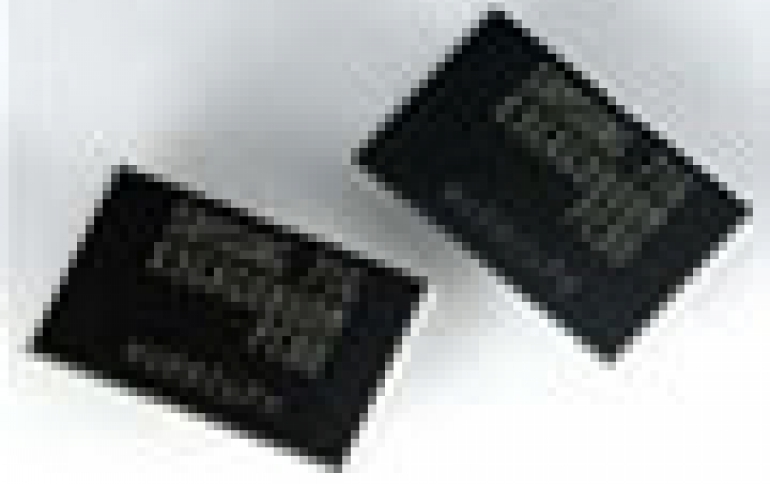
Samsung to Start 65nm PRAM Manufacturing in 2009
Samsung Electronics will begin mass production of 512MB PRAM (Phase change RAM) in the first half of the next year, in an effort to in order to maintain its leadership in the memory market.
The company said that it would begin the mass production of 65nm 512MB PRAM in
the first half of the next year for the first time in the world.
PRAM, known as perfect RAM, is the next generation memory chip which features the advantages of NAND and NOR flash memories.
The S. Korean company, unveiled its plans to relase samples of 65nm 512MB PRAM chips and begin the mass production in its 200mm manufacturing line within this year.
"We obtained tens of thousand PRAM samples in the 90 nano processing line. In the end of this year, we will release out pilot products. Next year, we will begin the mass production to allow clients to use and check the performances," Samsung's executives said, as etnews.co.kr report. The company added that its current PRAM products work when its width is less than 10 nanometers, but the it also works even in 7 nanometers, according to the company's research. "We are sure that PRAM will be available as less than 20 nanometer ultra micro memory," Samsung added.
Phase-change Random Access Memory (PRAM) uses a material that turns crystalline when heated. The clrystalline bits represent the logical "1" in the binary system of computers, while amorphous areas (bits) represent logical "0"
PRAM is also more scalable than any other memory architecture being researched and features the fast processing speed of RAM for its operating functions combined with the non-volatile features of flash memory for storage.
A key advantage in PRAM is its extremely fast performance. Because PRAM can rewrite data without having to first erase data previously accumulated, it is effectively 30-times faster than conventional flash memory. PRAM is also expected to have at least 10-times the life span of flash memory.
PRAM is expected to be a highly competitive choice over NOR flash, since it requires fewer process steps to produce than those used in the manufacturing of NOR flash memory.
Adoption of PRAM is expected to be especially popular in the future designs of multi-function handsets and for other mobile applications, where faster speeds translate into immediately noticeable boosts in performance.
Samsung introduced pilot products of 256MB PRAM for the first time in the world in 2005.
Hynix, Samsung's competitor in the memory market, also plans to complete the development of 54nm 512MB chips in the end of the next year to begin the mass production. Numonyx will also release 45 nano products in the end of the next year.
PRAM, known as perfect RAM, is the next generation memory chip which features the advantages of NAND and NOR flash memories.
The S. Korean company, unveiled its plans to relase samples of 65nm 512MB PRAM chips and begin the mass production in its 200mm manufacturing line within this year.
"We obtained tens of thousand PRAM samples in the 90 nano processing line. In the end of this year, we will release out pilot products. Next year, we will begin the mass production to allow clients to use and check the performances," Samsung's executives said, as etnews.co.kr report. The company added that its current PRAM products work when its width is less than 10 nanometers, but the it also works even in 7 nanometers, according to the company's research. "We are sure that PRAM will be available as less than 20 nanometer ultra micro memory," Samsung added.
Phase-change Random Access Memory (PRAM) uses a material that turns crystalline when heated. The clrystalline bits represent the logical "1" in the binary system of computers, while amorphous areas (bits) represent logical "0"
PRAM is also more scalable than any other memory architecture being researched and features the fast processing speed of RAM for its operating functions combined with the non-volatile features of flash memory for storage.
A key advantage in PRAM is its extremely fast performance. Because PRAM can rewrite data without having to first erase data previously accumulated, it is effectively 30-times faster than conventional flash memory. PRAM is also expected to have at least 10-times the life span of flash memory.
PRAM is expected to be a highly competitive choice over NOR flash, since it requires fewer process steps to produce than those used in the manufacturing of NOR flash memory.
Adoption of PRAM is expected to be especially popular in the future designs of multi-function handsets and for other mobile applications, where faster speeds translate into immediately noticeable boosts in performance.
Samsung introduced pilot products of 256MB PRAM for the first time in the world in 2005.
Hynix, Samsung's competitor in the memory market, also plans to complete the development of 54nm 512MB chips in the end of the next year to begin the mass production. Numonyx will also release 45 nano products in the end of the next year.





















